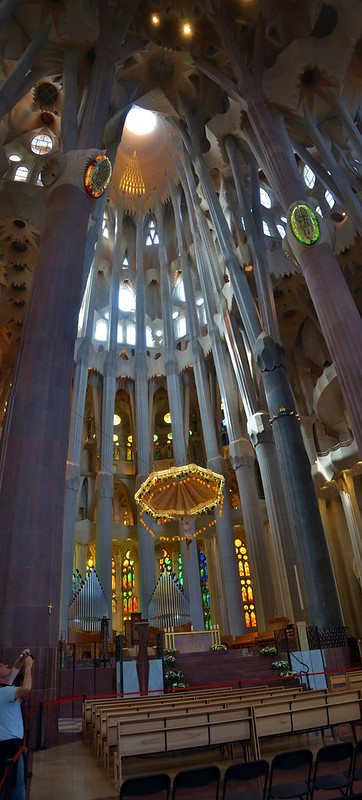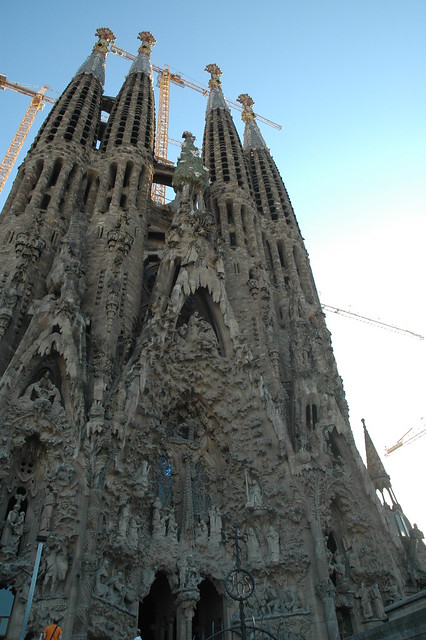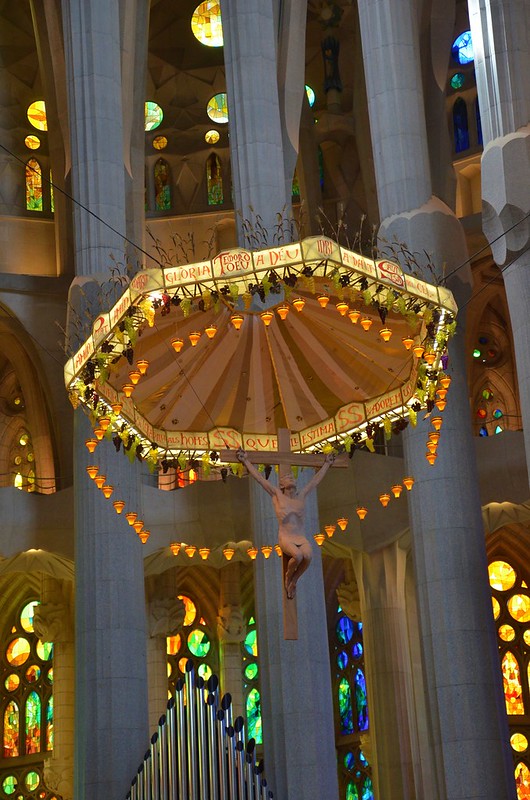So, in the race for “Chris’s favorite basilica,”
Sagrada Familia and St. Peter’s have always been neck-and-neck. St. Peter’s
interior and decorations pretty much blow any other church on earth out of the
water (when your the headquarters of the Catholic Church for several hundred
years, you tend to collect some swag), but I’ve always loved the exterior of
Sagrada Familia so much more.
In a nutshell, Sagrada Familia has the typical cross-shaped
layout of a basilica, with the Apse occupying the top section of the cross. The
other three arms are tipped with three facades, representing three aspects of
Christianity: the Nativity, the Passion, and the Glory (i.e. believers, faith,
and the Holy Trinity). The Passion and Nativity Facades are mostly done, but
the Glory Façade is just getting started. Currently, it just consists of the
door pictured below, with the Lord’s Prayer in Catalan in the center, and the
phrase “Give us this day our daily bread” in most of the world’s languages.
The Nativity Façade tells scenes fromthe story of Christ’s
birth, including the actual Nativity, the flight of the Holy Family to Egypt,
and Jesus teaching as a child in the temple. Modernisme (the architectural
movement Gaudi was a member of) focuses a lot on nature, plants, and animals,
and it really shows here. This façade is coated in little nubbly bits
representing animals, fruit, and flowers surrounding the Biblical scenes. The
main entrance through this façade is supported by pillars that end in two large
turtles, whose long-lives represent the eternal nature of God’s power. Oh, and
true to Barcelona’s orientation “La montans, y la mar” (the mountains and the
sea), the turtles represent the city’s surroundings. The turtle on the sea-side
of the entrance is a sea turtle, and the turtle on the mountain-side is a
mountain tortoise. This imagery also extends to the exterior of the apse, which
is covered in small animals “fleeing in awe of the Holy Spirit inside.”
 The Passion Façade is, obviously, much more stark and
somber, and features the other main aspect of Modernisme: geometry. The entire façade
is harsh angles and odd curves, and gives everything a kind of shocked and
inhuman feeling. The scenes here reflect the scenes of the Passion (you can see
most of them HERE), and the shapes of characters and imagery are all meant to
be simplistic and sad. My personal favorite part was the statue of the
Ascension, which I forgot to snap a photo of. It’s a brass statue that weighs
over 4 TONS, and is sitting on a stone slab waaaaaay up in the air. I also
liked the magic square near the scene of Judas’ betrayal (where there are over
300 ways to combine the numbers and get 33, Jesus’ age at death), and the
ripping of the sheet in the Temple, where you can see the light and colors of
God shining through.
The Passion Façade is, obviously, much more stark and
somber, and features the other main aspect of Modernisme: geometry. The entire façade
is harsh angles and odd curves, and gives everything a kind of shocked and
inhuman feeling. The scenes here reflect the scenes of the Passion (you can see
most of them HERE), and the shapes of characters and imagery are all meant to
be simplistic and sad. My personal favorite part was the statue of the
Ascension, which I forgot to snap a photo of. It’s a brass statue that weighs
over 4 TONS, and is sitting on a stone slab waaaaaay up in the air. I also
liked the magic square near the scene of Judas’ betrayal (where there are over
300 ways to combine the numbers and get 33, Jesus’ age at death), and the
ripping of the sheet in the Temple, where you can see the light and colors of
God shining through. When I was there last, they were just finishing up the roof,
and had maybe four stained glass windows in place. Now, the interior structure
is mostly complete, and the decorations are nearly there too. But, now that
Sagrada Familia’s interior is nearing completion, I have to say, it’s pulled
ahead in a massive way. The church is absolutely STUNNING inside. I was blown
away, and Sean’s reaction was, “It totally blew away my expectations, which
were pretty high to begin with after hearing you talk about it.”
When I was there last, they were just finishing up the roof,
and had maybe four stained glass windows in place. Now, the interior structure
is mostly complete, and the decorations are nearly there too. But, now that
Sagrada Familia’s interior is nearing completion, I have to say, it’s pulled
ahead in a massive way. The church is absolutely STUNNING inside. I was blown
away, and Sean’s reaction was, “It totally blew away my expectations, which
were pretty high to begin with after hearing you talk about it.”
The columns are all made using a complex geometric formula
that has them start as six-sided ones at the base, then slowly “grow” more and more
sides as they reach the top. Once they reach the top, they split into more
columns to simulate tree trunks supporting the ceiling, which is designed to
look like the canopy of a forest. This is supposed to simultaneously create a
sense of wonder at the scale of the church, while also making it feel enclosed,
private, and personal (goals which, oddly enough, it achieves). When the sun
sets, lights in the spaces between the “leaves” turn on, simulating seeing
stars peeking through.
Light and color in the church are AMAZING as well. The altar
and apse are surrounded by gold, stained glass, and windows, so it’s so full of
color, you don’t really know how to process it all. The windows to the east
(the Nativity façade) are blue and green, and the windows to the west (the
Passion façade) are oranges and reds, so the sunrise simulates spring, water,
and life, and the sunset simulates autumn.
The area behind the altar (where little chapels normally go)
was also done differently. Rather than having chapels and shrines to various
saints (which invariably get gated off to keep tourists out), it’s just a quiet
place where people can go, sit, pray, and think (the original purpose of the
chapels).
So yes, overall, Sagrada Familia is a very different church
from most of the cathedrals and basilicas you’ll find in Europe. It might not
have the gold and marble of St. Peter’s, but it more than makes up for that in
character, creativity, and the thought that went into all the details. Even
things that you wouldn’t think of (like the decorations around windows you can
only see from the towers, the use of spring fruits on the Nativity towers and
autumn fruits on the Passion towers) have a reason behind them.
All in all, it’s an absolutely fantastic church, and worth
the visit to Barcelona all on its own. I see at least one more trip to Barca in
my future, somewhere on the order of 2026-2028, when it’s supposed to be
completed.





Wow....
ReplyDelete